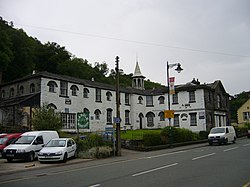Corwen
| Corwen | |
| Merionethshire | |
|---|---|
 The former workhouse, Corwen | |
| Location | |
| Grid reference: | SJ075435 |
| Location: | 52°58’48"N, 3°22’44"W |
| Data | |
| Population: | 2,398 (2001) |
| Post town: | Corwen |
| Postcode: | LL21 |
| Dialling code: | 01490 |
| Local Government | |
| Council: | Denbighshire |
| Parliamentary constituency: |
Clwyd South |
Corwen is a town in Merionethshire, on the banks of the River Dee beneath the Berwyn mountains. The town is 11 miles west of Llangollen. As at the 2001 census, Corwen had a population of 2,398.
Located in the north of the Cambrian Mountains, in the west of Merionethshire, the main economy of Corwen is based in and around farming. The town's main employer is local trailer manufacturer Ifor Williams Trailers, started by a farmer looking to transport sheep to the local market.
History
On 16 September 1400, it was near Corwen that Owain Glyndŵr, who proclaimed himself Prince of Wales. Glyndŵr's declaration was made at his nearby manor of Glyndyfrdwy, and this began his fourteen-year rebellion against King Henry IV and the marcher lords.[1] A life-size bronze statue of the prince mounted on his battle horse was installed in The Square in 2007, to commemorates the day he was proclaimed prince of Wales.[2]
The town grew as a centre for cattle drovers. Attractions in Corwen include the motte of a Norman castle, the thirteenth century Church of St Mael and St Sulien and the Capel Rûg built in 1637 by William Salesbury.
Transport
In the 1860s Corwen was linked to the national rail network in 1864 by a line from Ruthin along the Vale of Clwyd and in 1865 with a Great Western Railway branch line along the Dee valley from Ruabon. The station was a vital development in the town's importance as the centre of the local Agriculture industry. Neither survived the Beeching Axe in the 1960s. However, the heritage Llangollen Railway, on the same alignment as the former GWR line, was opened as far as Corwen in 2014.
Corwen is the last sizeable town on the A5 road from London to Holyhead until Betws-y-Coed is reached. Because of this it still contains a number of hotels which were used in the past as coaching inns for the Mail coach and stagecoaches. Although the A5 is no longer the most important road to Holyhead, having been superseded by the coastal route of the A55, there is still significant traffic travelling through the town centre’s narrow main street.
Culture
Corwen hosted the National Eisteddfod in 1919. The Pavilion in the town has played an important part in Welsh culture throughout the 20th century. It has hosted several concerts and eisteddfodau. It was also the venue for the first concerts performed by Edward H Dafis, the first Welsh-language rock band to receive significant press notice, in August 1973.
Novelist John Cowper Powys (1872-1963) lived in Corwen with his common-law wife Phyllis Playter from 1935 until 1955, when they moved to Blaenau Ffestiniog.[3] He wrote two major novels both set in this region of Wales, while living in Corwen, Owen Glendower (1940) and Porius (1951), amongst other works of both fiction and non-fiction.
Outside links
References
- ↑ "Glyndyfrdwy". Castlewales.com. http://www.castlewales.com/gldwr_mt.html. Retrieved 2013-05-28.
- ↑ Corwen's new statue of Owain Glyndwr, Geograph, 13 September 2007, http://www.geograph.org.uk/photo/628404, retrieved 28 December 2007
- ↑ Morine Krissdottir, Descent of Memory: The Life of John Cowper Powys. New York & London: Overlook, 2007.